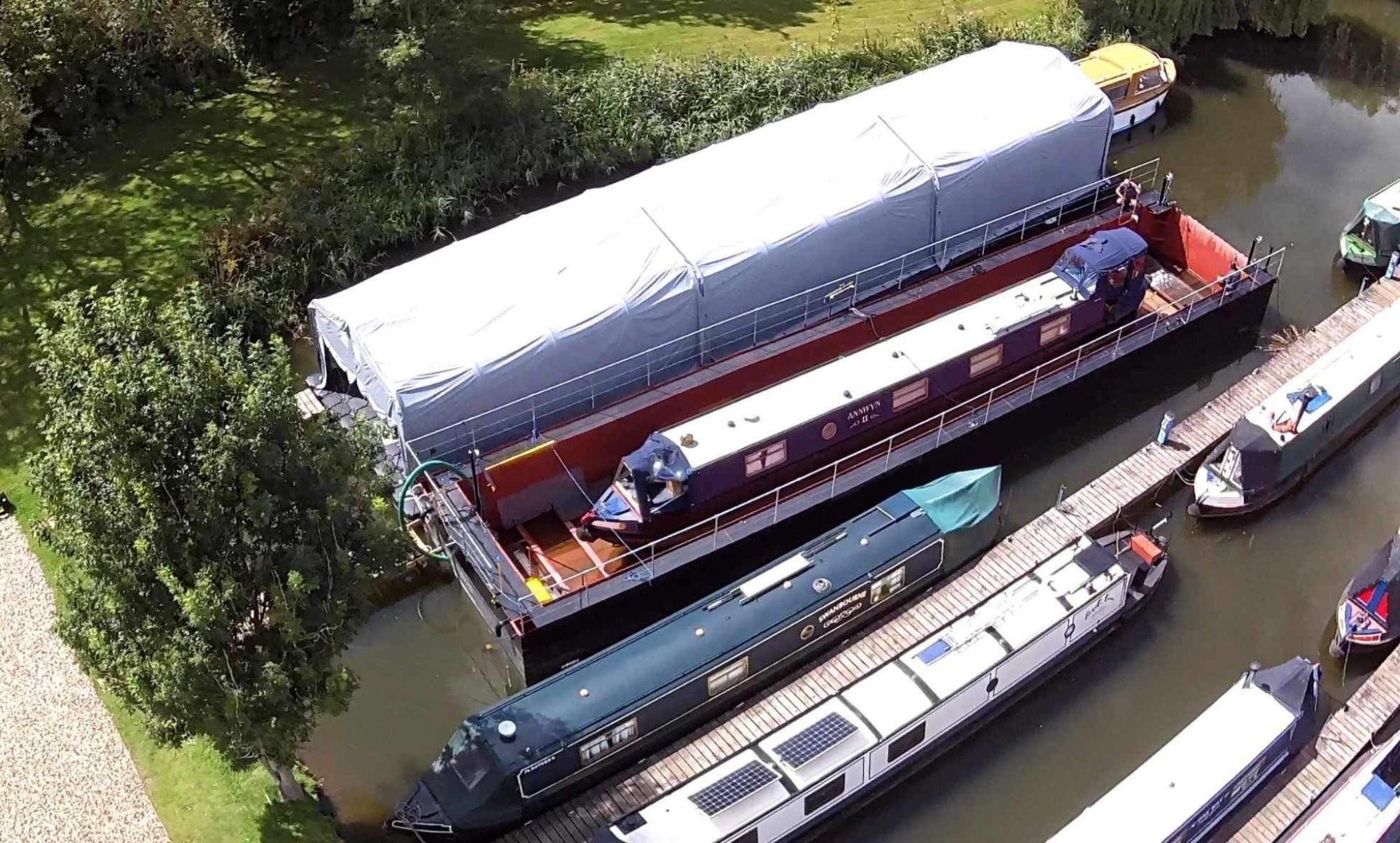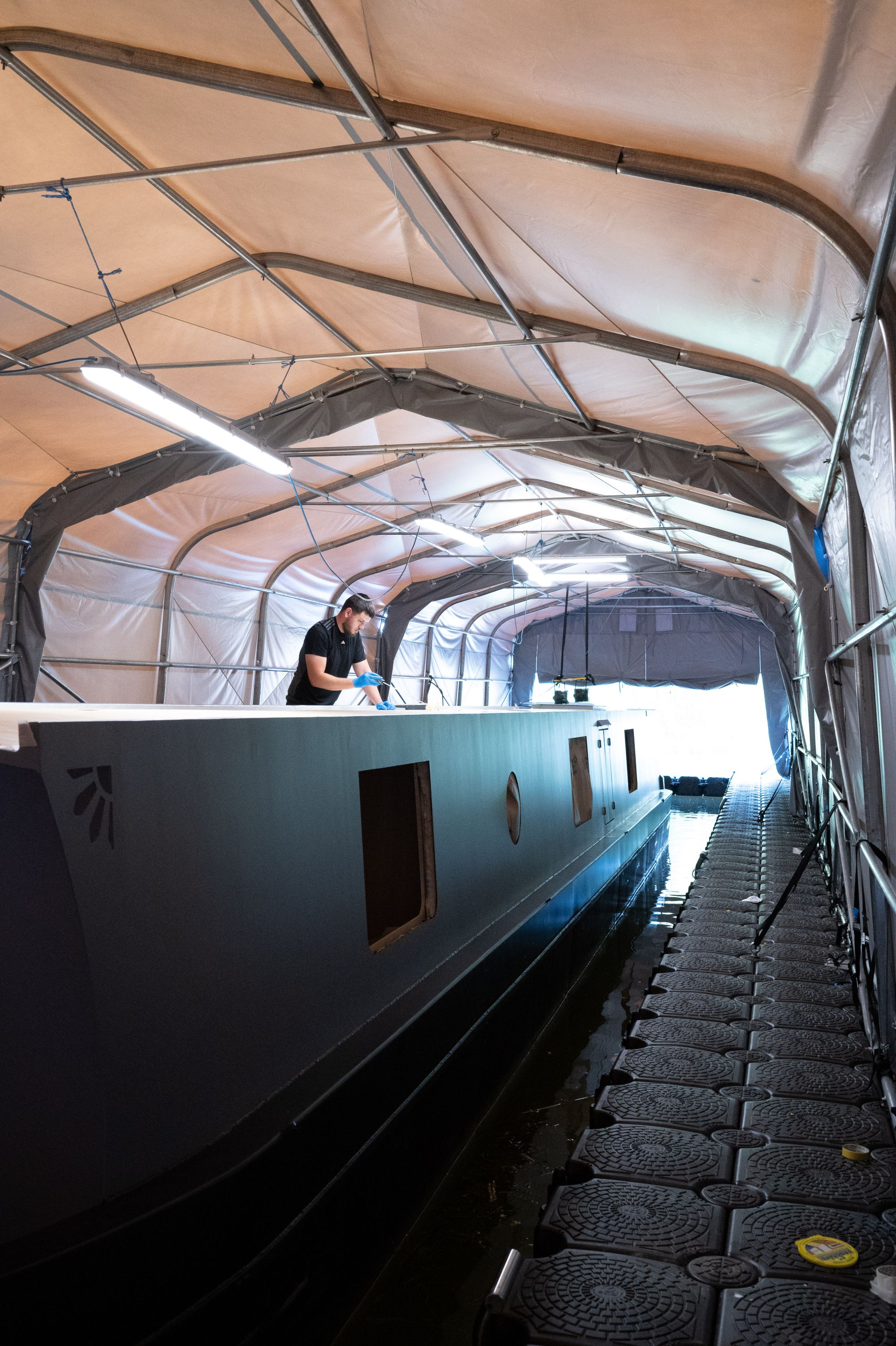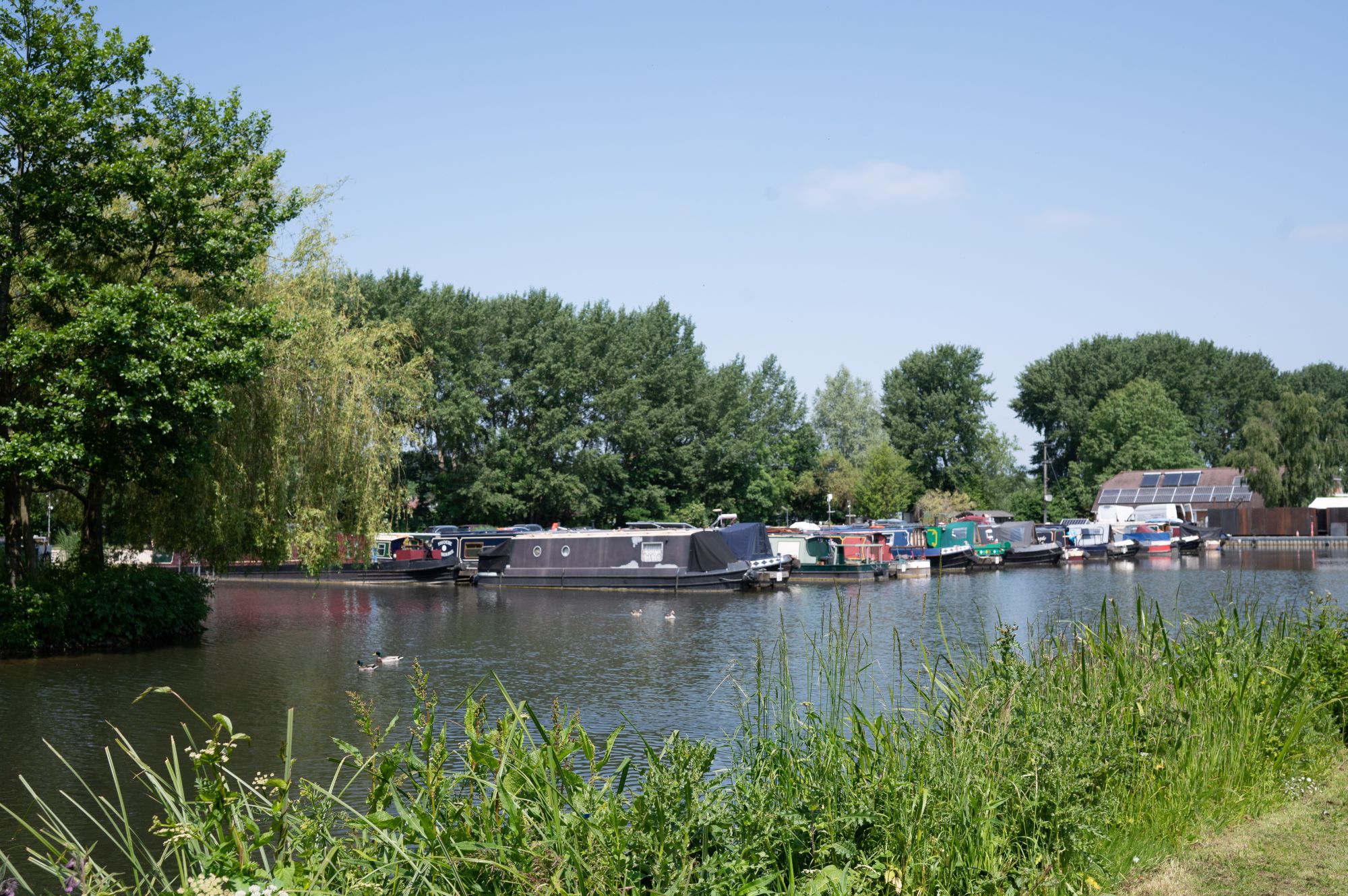The Wasing Whale

We are very excited to announce the launch of our brand new floating dry dock at Frouds Bridge Marina.
Affectionately dubbed the “Wasing Whale” by Frouds Bridge berth holders, this freshly installed out-of-water facility has been introduced to provide the local and visiting boating community maintenance and repair services including blacking, anode replacements and rudder & skeg works.
The customised floating dry dock has been welded and installed by a highly skilled local Berkshire-based team, using 32 tonnes of steel, 12 miles of weld and over 100 litres of paint for its assembly. In addition to the dry dock, a new paint tent has been installed, offering berth holders a convenient and quality service.
“We’re delighted that the new dry dock is now afloat & have received enormously positive feedback from our customers. Due to its size, craning the dry dock into the water was a nerve-wracking moment but it all went swimmingly & we’re so pleased to see so many boats coming in in need of works & leaving looking and running beautifully”.
- Matt Stroud, Manager at Frouds Bridge Marina

Andy Spiceley, one of our berth holders & owner of Pelekas, has kindly shared his story of the Wasing Whale:-
Sooner or later, most boat owners will be looking for appropriate facilities for external below-the-waterline maintenance, whether for routine blacking and anode replacement, or other work such as attention to the rudder & skeg. With the growth in boat numbers on the Kennet and Avon, the team at Frouds Bridge marina near Aldermaston had for some time been considering how to offer an “out-of-the-water” facility alongside existing services.
When Matt Stroud, marina manager, began working on a plan to introduce docking facilities, it was soon clear that a floating dry dock was the only viable option. The marina is on the volatile River Kennet, where the water level can change by several feet very quickly, and the only available space to install and operate a dock is close to the river, where the land is very soft. Fixed structures such as a permanent dry dock or slipway require planning permission, and regular use of a crane – even if there had been suitable firm ground and adequate space – is not permitted under restrictive planning covenants.
When the project was announced to marina users I was fascinated to know, given the constraints on site, how it was going to be achieved. What follows is a distillation of a complex undertaking which, like the proverbial waterfowl, looked smooth and flowing from the outside, but in reality, depended on a lot of hard work behind the scenes!
So how do you go about making your own floating dry-dock? Although there are several examples around the canal network, no two are identical: this is not an “off-the-shelf” product.
Initially Matt consulted industry specialists Pontoon & Dock who were able to provide basic design drawings of a generic floating dry dock of the required dimensions. The design was customised during detailed planning of the construction – for example making it higher to allow for the significant changes in water level on the Kennet.
It was soon obvious that, with the escalating price of steel, the project would soon become un-economic so the decision was taken to go-ahead using local expertise as far as possible, working with an in-house team and supported by specialist contractors where necessary. Fortunately Dave Lane, an experienced marine welder and fabricator, is a marina berth-holder, and had previously built the dry-dock at Greenham Lock marina in Newbury; he and Nick Peppitt of Hollington Forge handled all the welding and fabricating.
One very significant factor which shaped the project was the question of how to assemble and launch the completed dock, given the constraints of soft land next to the water, small and twisty access roads and very limited open space. The answer was to build relatively small sections of the dock which could be fabricated by Dave off-site and delivered one by one. The dock could then be stitched together in situ ready for lifting into the water. [picture]
The next planning challenge: getting the completed dock into the water. Clearly this was going to require specialist expertise and a very big crane! Lifting contractors KAS & Southern Cranes looked at the area where the dock was going to be assembled and advised that it could not be lifted there without considerable disruption to the marina grounds and building of an appropriately firm road bed for the crane. The only feasible option was to perform the lift from the bank adjacent to the marina office, bungalow and boat fuel/service point. This required in turn that assembly and fitting out of the dock had to be re-located. Back to the drawing board!
As is typical of so many large projects, there was a real sense of acceleration towards the end; after years of deliberation and analysis, and months of careful planning and preparation, the fruits of the work suddenly became tangible. Over a period of a few weeks, a big steel boxes starting appearing on the bank. [picture]. Big cranes have to be booked a long time in advance; so having estimated when the dock would be ready, and made a firm booking, there was a serious deadline to finish fitting out the dock with doors, pumps, & railings, and apply large quantities of paint, against a backdrop of extreme weather conditions – from torrential rain and high wind to heatwaves. Large quantities of tea were consumed during this period!
The most dramatic spectacle of the entire project was of course the lift. For Matt, this was also the most nerve-wracking, since, notwithstanding all the thorough analysis and preparation, the lift had to be performed in the restricted space next to his bungalow and the fuel and pump-out points. There was little margin for error and it had to work first time without a rehearsal.
Despite making preparations in advance as far as possible (including clearing space for the crane and its stabilisers, laying a firm base for the 55 tons of ballast, and preparing the access road) a very early start was needed on the big day. It was very early indeed for the crane crew – the low road speed of the crane meant a 1:30am start for them to get to the marina at the required time! After hours of preparation, all was ready, and with no fuss at all, the dock was smoothly lifted into the water. [pictures].
The remaining tricky task was to move the dock from the launch site into its operating position at the opposite end of the main pool – a manoeuvre not anticipated as part of the initial design considerations. With just 500mm of clearance each side between the dock and the ends of the mooring pontoons, the dock was roped very carefully along the marina to its final destination.
So, with 32 tons of steel assembled with 12 miles of weld, over 100 litres of paint (not to mention 250 cups of tea) the moment arrived to see how well it works in practice and find out if the various design decisions had been correct! Would the theory of how the dock should behave when emptying and flooding be met in practice? The first trial showed that the dock would rise and fall very evenly with minimal use of the ballast tanks.
Of course, you can’t launch a vessel (and arguably, the dock is a vessel) without giving it a name. Matt invited marina berth holders to come up with a name; and the winning entry was The Wasing Whale – referencing the marina owners, Wasing Park Estate.
I asked Matt whether, after seeing such a complex project from the first concept to the dramatic culmination of the lift and final commissioning, there was afterwards any sense of anti-climax in the team; “no time for that”, he replied, “now we have to organise how we will feed the whale and manage its appetite for blacking materials!”
Looking back, Matt commented that the most satisfying aspect of the project is that it demonstrates that, with the right planning and preparation, even a large undertaking such as this can be managed and delivered by a skilled local team.

